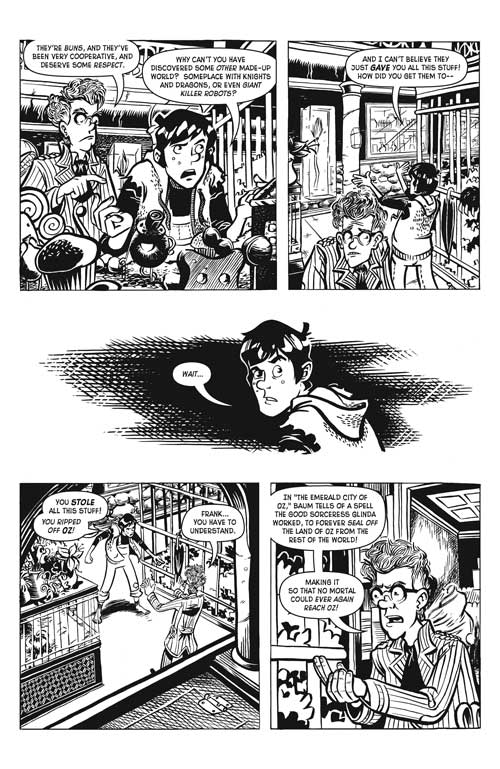The Royal Historian Of Oz
Tommy Kovac & Andy Hirsch
The Royal Historian of Oz is one of the many comic books to build on the modern fairy tales of the turn of the last century. Oz, Wonderland and Neverland have all become geographical back drops for comics. Because Oz is an epic sprawling fantasy with plenty of room for interpretation while falling safely in the public domain, it is a natural enough fit for comics.
One thing that sets The Royal Historian of Oz apart is the way it actively and self-referentially places its self in the tradition of Oz adaptions. For example, even Kovac's title is an allusion to a tradition, started by Frank Baum, of referring to the author of Oz stories as a 'historian' of Oz.
The Royal Historian of Oz starts off in a slightly alternate near future. Like Baker Street's London, Kovac's "broke-down weary future" allows for greater literary license and zeppelins. The story follows Frank and his father Jasper Fizzel. To Frank's chagrin, Jasper is persistently cranking out Oz fan fiction to the detriment of any help to the household. Jasper is hounded by the ruthless but ridiculous fictional Official Oz Society (not the real International Wizard's of Oz Club). The Official Oz Society police all Frank Baum's intellectual properties. In a fantastic turn of events, Jasper manages to cross over into Oz in an attempt to vindicate himself. This only manages to make more of a mess of things for everyone and leaves Frank stuck in the middle.
 In researching this review, I found a copy of Wonderland. It utilizes the writing talents of Kovac and the illustrations of Sonny Liew. Kovac clearly has an understanding of the inner-workings of the modern fairy tale. He also has a glibness that is contemporary without being anachronistic. He keeps The Royal Historian of Oz accessible to readers whose knowledge of Oz is limited to passing familiarity with Scarecrow, Dorothy and Ozma. Nevertheless Kovac does spend a little time geeking out on less known members of the Oz pantheon like Button Bright and the Glass Cat. Tommy Kovac also has a pretty comprehensive web page and a highly entertaining blog.
In researching this review, I found a copy of Wonderland. It utilizes the writing talents of Kovac and the illustrations of Sonny Liew. Kovac clearly has an understanding of the inner-workings of the modern fairy tale. He also has a glibness that is contemporary without being anachronistic. He keeps The Royal Historian of Oz accessible to readers whose knowledge of Oz is limited to passing familiarity with Scarecrow, Dorothy and Ozma. Nevertheless Kovac does spend a little time geeking out on less known members of the Oz pantheon like Button Bright and the Glass Cat. Tommy Kovac also has a pretty comprehensive web page and a highly entertaining blog.For me, Andy Hirsch steals the show. There isn't as much multi-panel motion as his self produced Varmints. In The Royal Historian of Oz panel breakdown would be most dictated by Kovac's script. Hirsch's talent mostly shines through in his panel composition. When talking about panel composition it is easier to talk about it in terms of camera angles. Hirsch shoots up, down and off to the sides that allow for a sense of motion in static single panel. Take a look at the fourth panel of page above. There is a minimum of action in the page as dialogue goes back and forth. The over head angled shot gives the impression that you actually saw the steps as Frank pivots and points. Another thing to check out is all of the chewy scenery. The level of detail in the first two panels is a mainstay of the book. To give him feed back or check out what he is currently working on, visit A is for Andy or darnvarmints.
Jasper brings a flying monkey named Zik back from Oz. Zik is monosyllabic with a noticeably inhuman face. Zik's ability to emote and his comic timing really highlight the strength of Kovac and Hirsch's collaboration. Both men are capable of stealing a scene. For example note some of Jasper's monologues or the visual funkiness of Patchwork Girl at the end of issue four. But I feel that there is an equilibrium on the character of Zik that shows off what both men bring to the work.
You can buy the individual issues or the pocket sized trade paper back from Slave Labor Graphics. The first three issues are also for sale from the Comixology smart phone application.
No comments:
Post a Comment